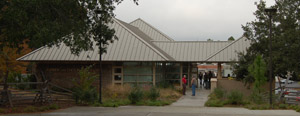 Public anthropology is the interpretation of the archaeological record, the historical record, and eye-witness accounts for a contemporary audience.
Mary Spanos is currently working on a public anthropology project for the University of South Alabama.
Dr. Greg Waselkov
is leading the construction of a natural history museum in the new
Delchamps Archaeology Building.
Mary is researching, designing, and constructing the clothing and textile props for the prehistoric and early historic figures.
This 2000-year survey of clothing on the Gulf Coast, and the very different attitudes toward clothing of the two principle groups of residents, presents many challenges.
Public anthropology is the interpretation of the archaeological record, the historical record, and eye-witness accounts for a contemporary audience.
Mary Spanos is currently working on a public anthropology project for the University of South Alabama.
Dr. Greg Waselkov
is leading the construction of a natural history museum in the new
Delchamps Archaeology Building.
Mary is researching, designing, and constructing the clothing and textile props for the prehistoric and early historic figures.
This 2000-year survey of clothing on the Gulf Coast, and the very different attitudes toward clothing of the two principle groups of residents, presents many challenges.
The work on these costumes is presented below and is updated as the work progresses. Use the following links to jump to a particular figure:
-
Granddaughter and
Grandmother
collecting
oysters in the Woodland era,
Mississippian-era Chief,
French trader from the 1750s, and
Lucrecia Perryman, a former slave and well-documented historic figure from about 1900.
Accuracy is the goal, but time and money are constraints for any project. The first four figures listed above would have lived prior to the industrial revolution. Therefore, to produce completely accurate clothing would have begun with the hunting and gathering, or horticultural production, of textile fibers. These plant and animal fibers would have been prepared for spinning, the yarn would have been spun, and the cloth would have been twined, woven, or knitted. All of these processes are possible, but labor intensive, and alternative solutions were needed. For this project, the appearance of accurate reproduction that would convey the most important information to the museum visitor was the goal. With clothing, achieving an accurate appearance began with the fiber content of each item. For example, the prehistoric Indian clothing would have originally been made from the variety bast fiber plant material available on the Gulf Coast (Whitman 1941). Though the Woodland-era reproductions were primarily made from commercially produced yarns, the fiber content encompasses the currently available bast fiber yarns available.
Textile impressed sherds from Beckum Village (1Ck24) in Clarke County, Alabama, are shown below and are being used for some fabric structure choices for this project. Analysis of the textile impressions on the saltpan sherds from this site suggest that Beckum Village was used by small groups of Southeastern Indians, possibly families (Spanos 2006). The use of these artifacts does not suggest that the residents of Beckum Village were from the Mobile area. On the contrary, some archaeologists believe that the people who used Beckum Village for salt production traveled down the Tombigbee River from further north. Regardless, the fabrics impressed into the Beckum Village saltpans appear to be a wide variety of personal fabrics, rather than something specially made for the production of saltpans, which provides valuable information for the reproductions being created for the University of South Alabama museum.
Woodland Granddaughter, a young girl
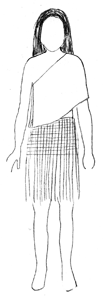
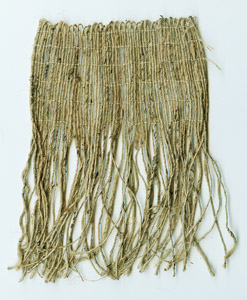
The Woodland granddaughter's garments have not been constructed yet. As work commences, photographs of the twined fabrics and garments will be posted here. The sketch, at left, represents the current plan for the reproductions of the granddaughter's prehistoric garments. Concepts of prehistoric Southeastern clothing are based on archaeological evidence and research, a survey of prehistoric art, and early European descriptions that will be presented by Mary at SEAC 2009. These suggest that Southeastern Indian cloth garments were rectangles that were wrapped around the body, either as a skirt or as a mantle. The current plan for the granddaughter is that she will wear a skirt made of twined cloth, constructed with nettle fiber yarn, which is currently being processed and handspun in Nepal by a cottage industry. A swatch of plain spaced twined fabric is shown at left.
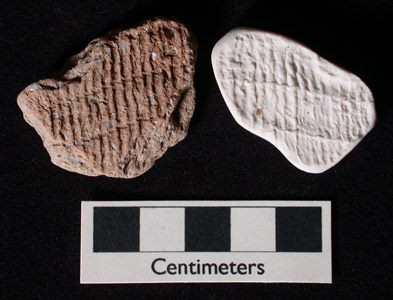
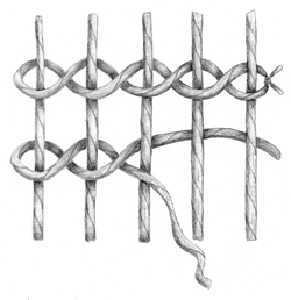 Plain spaced-twined fabric was found among the fabric impressions found at archaeological sites at Bottle Creek and in Clarke County, Alabama (Drooker 2003, Spanos 2006). A plain spaced-twined impressions from Beckum Village is shown above. An illustration of how plain spaced-twined fabric is constructed is shown at left. The granddaughter's skirt fabric will be twined from the waist to just below the crotch, then the veritcal threads will hang loose to the knees.
Plain spaced-twined fabric was found among the fabric impressions found at archaeological sites at Bottle Creek and in Clarke County, Alabama (Drooker 2003, Spanos 2006). A plain spaced-twined impressions from Beckum Village is shown above. An illustration of how plain spaced-twined fabric is constructed is shown at left. The granddaughter's skirt fabric will be twined from the waist to just below the crotch, then the veritcal threads will hang loose to the knees.
Woodland Grandmother
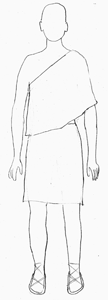
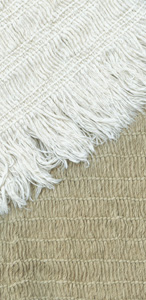
An unidentified man who traveled with De Soto and who is commonly referred to as "a Gentleman from Elvas" described Southeast Indian women's attire in 1539: At Toalli, "the tribute paid them by their Indians, which consists of maize and deerskins and native blankets resembling shawls, some being made of the inner bark of trees and some from a plant like daffodils which when pounded remains like flax. The Indian women cover themselves with these blankets, draping one around themselves from the waist down and another over the shoulder with the right arm uncovered in the manner and custom of Gypsies" (Clayton, Knight, and Moore 1995:76).
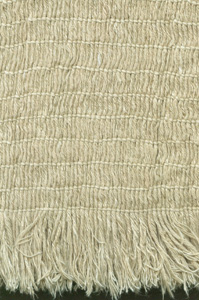
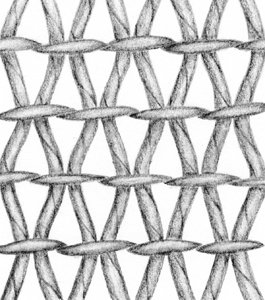
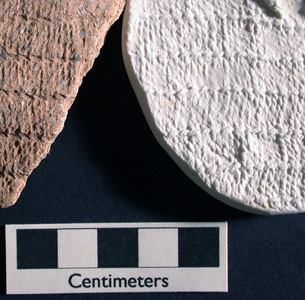
The cloth of the grandmother's skirt and mantle is a textile structure called alternate-pair twining. This fabric structure can be seen at right in the Beckum Village sherd and white cast of the sherd's surface, in the illustration, and in the photograph of the grandmother's skirt at far right. The Grandmother's clothes are made from commerical hemp yarn. Hemp, a bast fiber, is used here in place of the bast fiber yarns that would have been used by the original Woodland grandmother. She would have gathered the plant fiber she needed, processed it to prepare it for spinning, spun the yarn, and then twined the cloth. Bast fiber cloth, such as the linen that we wear today, is very hard-wearing. The Grandmother's clothes would have begun their use-life fairly stiff and would have softened over time due to wear and washing.
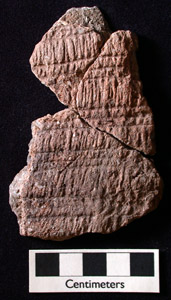
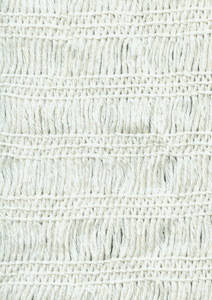
The grandmother's mantle is also alternate-pair twined (see photo of cloth at near left), but the twining rows are spaced to give the cloth a more decorative appearance (a similar textile impression can be seen on the Beckum Village pot sherds at far left). By our modern standards, the granddaughter's fur mantle would be considered more prestigious but, the grandmother's mantle would have required more labor to construct and that might have made it more valuable to the earliest Mobile residents.
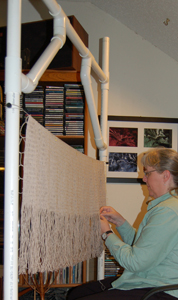
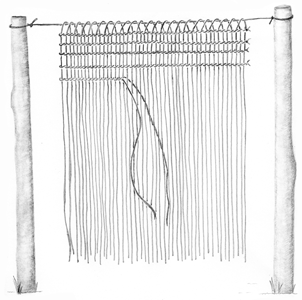
The twined cloths for the USA museum are being created on a modern version of an early Southeast Indian twining stand described by Le Page Du Pratz, a Frenchman in the New Orleans area in the 18th century (Le Page Du Pratz 1972). A drawing made from his written description is shown at near right. A modern version made by Michael Spanos for this project, which uses PVC pipe to create a portable twining stand for a modern home, is shown at the far right with Mary Spanos working on the Grandmother's skirt. While the twining stand and the environment are modern, the finished cloth will be a fair reproduction of the archaeological evidence.
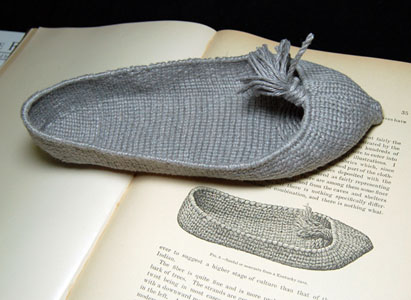
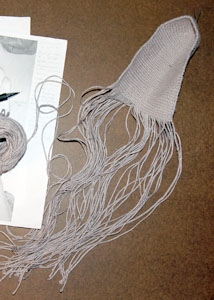 The grandmother will wear shoes made from twined bast-fiber yarn.
They were made to reproduce the shoe in the 1896 drawing by William H. Holmes of a shoe recovered from a cave in Kentucky (Holmes 1896).
The near left photo shows the contruction of the shoe in progress. This shoe is an ingeneous construction, a twined cloth similar to the skirt or mantle cloth, but shaped to create this three-dimensional form.
The grandmother will wear shoes made from twined bast-fiber yarn.
They were made to reproduce the shoe in the 1896 drawing by William H. Holmes of a shoe recovered from a cave in Kentucky (Holmes 1896).
The near left photo shows the contruction of the shoe in progress. This shoe is an ingeneous construction, a twined cloth similar to the skirt or mantle cloth, but shaped to create this three-dimensional form.
Mississippian Chief
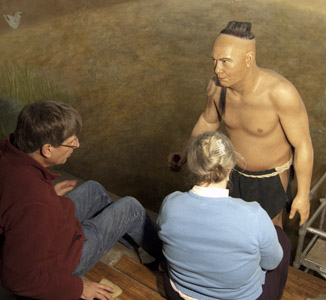
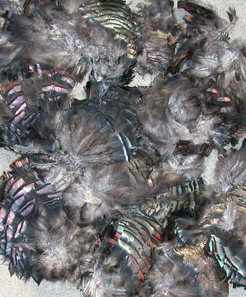
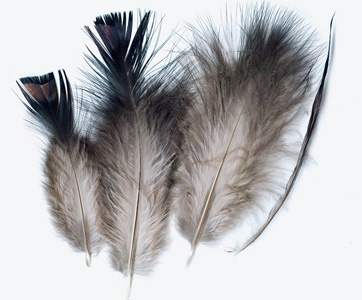
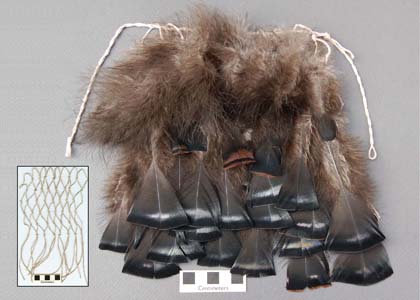 Construction is under way for the Mississippian chief's feather mantle.
The photo above left, shows the chief without the mantle. He wears a colored deerskin leather breechclout and deerskin mocccasins.
The Gentleman from Elvas, traveling with DeSoto in 1539, described the Southeastern Indian male attire as:
"The Indian men wear only one over the shoulders in the same way and have their privies covered with a truss of deerskin resembling the breech clouts formerly worn in Spain. The skins are well tanned and are given the color that is desired; and so perfectly that if the color is vermillion, it seems to be very fine grained cloth, and that colored black is splendid. And of this same they make shoes. They give the same colors to the blankets" (Clayton, Knight, and Moore 1995:76).
Construction is under way for the Mississippian chief's feather mantle.
The photo above left, shows the chief without the mantle. He wears a colored deerskin leather breechclout and deerskin mocccasins.
The Gentleman from Elvas, traveling with DeSoto in 1539, described the Southeastern Indian male attire as:
"The Indian men wear only one over the shoulders in the same way and have their privies covered with a truss of deerskin resembling the breech clouts formerly worn in Spain. The skins are well tanned and are given the color that is desired; and so perfectly that if the color is vermillion, it seems to be very fine grained cloth, and that colored black is splendid. And of this same they make shoes. They give the same colors to the blankets" (Clayton, Knight, and Moore 1995:76).
A generous donation of wild turkey feathers was received from William B. Turner (body feathers are shown above center). The feathers of the wild turkey are truely beautiful, full of surprising iridescence. While great pains were taken to preserve the feathers, a few did become soiled in transport or storage (feathered skin, wing, and tail were removed from the bird and frozen until thawed for feather removal). Soiled feathers, above at right, have been gently washed. The stick-like thing on the far right in the clean feather photo is a feather after washing and before fluffing. The sample swatch of feathered netting, above left, may give a rough idea of the plans for the feathered mantle. The small inset photograph shows the netting, the foundation for the feathered mantle. A feather is tied to each knot. The current plan is for a feathered mantle netted foundation 40-inches wide by 60-inches tall. This will require an estimated 4,500 feathers. This is estimated to be the feathers of four wild turkeys.
1750 French Trader
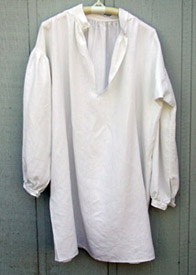
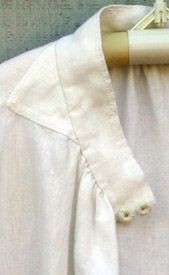 The Frenchman's costume was the first to be constructed.
The blouse was made from linen and the breeches were made from wool. Linen and wool were the primary fabrics used in clothing since the Middle Ages
Time and resources were focused on the two most visible parts, the blouse and the stockings; the blouse was entirely handsewn and the stockings were hand-dyed fiber, hand-spun yarn, and hand-knit.
Given that the blouse would be closer to the museum visitor's view, and the off-white color would make its construction more visible, the blouse was entirely sewn by hand (after all, the sewing machine did not exist in 1750).
The blouse was made from half-bleached linen and sewn with 60/2 linen thread.
Patterns and supplies for museum costumers and re-enactors are available.
Fabric, thread, thread-buttons, and patterns for the Frenchman were purchased from
W. M. Booth, Draper.
While the patterns used for this Frenchman were for British chstume, Johnson, Forbes, and Delaney's Historic Colonial French Dress provided descriptions that were quite similar to the patterns for British garments.
Minor modifications were made to the blouse according to Johnson, Forbes, and Delaney's descriptions.
The blouse pattern was "Man's Shirt 1750-1800" by Kannik's Korner.
The Frenchman's costume was the first to be constructed.
The blouse was made from linen and the breeches were made from wool. Linen and wool were the primary fabrics used in clothing since the Middle Ages
Time and resources were focused on the two most visible parts, the blouse and the stockings; the blouse was entirely handsewn and the stockings were hand-dyed fiber, hand-spun yarn, and hand-knit.
Given that the blouse would be closer to the museum visitor's view, and the off-white color would make its construction more visible, the blouse was entirely sewn by hand (after all, the sewing machine did not exist in 1750).
The blouse was made from half-bleached linen and sewn with 60/2 linen thread.
Patterns and supplies for museum costumers and re-enactors are available.
Fabric, thread, thread-buttons, and patterns for the Frenchman were purchased from
W. M. Booth, Draper.
While the patterns used for this Frenchman were for British chstume, Johnson, Forbes, and Delaney's Historic Colonial French Dress provided descriptions that were quite similar to the patterns for British garments.
Minor modifications were made to the blouse according to Johnson, Forbes, and Delaney's descriptions.
The blouse pattern was "Man's Shirt 1750-1800" by Kannik's Korner.
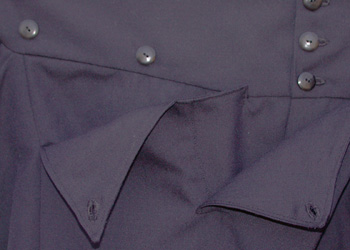
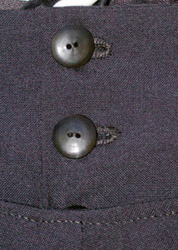
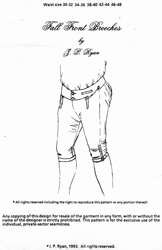 The Frenchman's breeches are made from a lightweight black wool.
The pattern, left, was created by
J. P. Ryan.
The visible stitching, such as the thirteen buttonholes and top-stitching as shown in the center photograph above, was done by hand. The photo above far right shows the right front of the breeches; on the left side of the photo--falling forward--is the flap over the pocket, on the right side of the photo--falling forward--is the fall front of the breeches.
A modern sewing machine was used for the less noticeable construction in order to reduce the time requirements for completing the breeches.
Fortunately, the pattern instructions were written for just such a type of construction.
This Frenchman will wear brass buckles to cinch up the breeches at his knees, which will help to hold up his stockings.
The Frenchman's breeches are made from a lightweight black wool.
The pattern, left, was created by
J. P. Ryan.
The visible stitching, such as the thirteen buttonholes and top-stitching as shown in the center photograph above, was done by hand. The photo above far right shows the right front of the breeches; on the left side of the photo--falling forward--is the flap over the pocket, on the right side of the photo--falling forward--is the fall front of the breeches.
A modern sewing machine was used for the less noticeable construction in order to reduce the time requirements for completing the breeches.
Fortunately, the pattern instructions were written for just such a type of construction.
This Frenchman will wear brass buckles to cinch up the breeches at his knees, which will help to hold up his stockings.
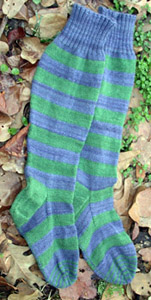
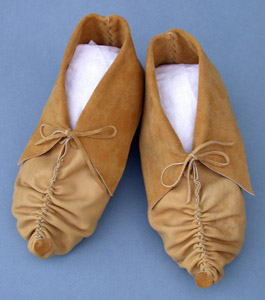 Striped stockings were common (Johnson, et.al. 1982). The wool in these stockings is commerically prepared Shetland.
Shetland is an old British breed, rather than French, but it presents a common type of wool.
The wool was dyed with synthetic dyes to appear to be indigo and the green should appear to have been created by the use of a yellow dye that was then overdyed with indigo.
The irregular dyeing of the blue and green, seen as shade variation within the stripes, presents the idea that the wool was dyed in a small batch and then not well blended, as though these stockings were made in a small production site, such as a home, and have faded with use (fading can make irregular dyeing more prominent).
Guidance for type and size of yarn, and the knitted gauge was found in French artifacts recovered at the excavation of the ship, Le Machault, which had sailed from France to Canada in 1760, only to be lost in a battle with the British (Davis 1982).
Striped stockings were common (Johnson, et.al. 1982). The wool in these stockings is commerically prepared Shetland.
Shetland is an old British breed, rather than French, but it presents a common type of wool.
The wool was dyed with synthetic dyes to appear to be indigo and the green should appear to have been created by the use of a yellow dye that was then overdyed with indigo.
The irregular dyeing of the blue and green, seen as shade variation within the stripes, presents the idea that the wool was dyed in a small batch and then not well blended, as though these stockings were made in a small production site, such as a home, and have faded with use (fading can make irregular dyeing more prominent).
Guidance for type and size of yarn, and the knitted gauge was found in French artifacts recovered at the excavation of the ship, Le Machault, which had sailed from France to Canada in 1760, only to be lost in a battle with the British (Davis 1982).
This Frenchman wears Indian moccasins to suggest that he is using a trade item. These Southeastern deerskin moccasins were described in the Bulletin of Primitive Technologies (Wood 2000).
1900 Midwife Lucrecia Perryman
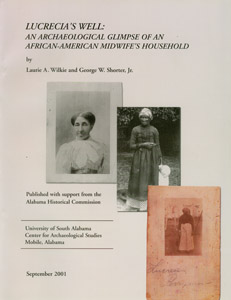
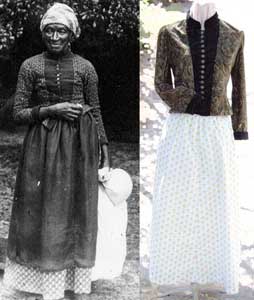 The Perryman museum figure is based on an individual who resided in the Mobile area and was photographed, so the design of her garments are based on a photograph rather than on written descriptions of archaeology or history.
Lucrecia's Well: An Archaeological Glimpse of an African-American Midwife's Household by Laurie A. Wilkins and George W. Shorter is available at the museum's gift shop and from the
Center for Archaeological Studies.
The Perryman museum figure is based on an individual who resided in the Mobile area and was photographed, so the design of her garments are based on a photograph rather than on written descriptions of archaeology or history.
Lucrecia's Well: An Archaeological Glimpse of an African-American Midwife's Household by Laurie A. Wilkins and George W. Shorter is available at the museum's gift shop and from the
Center for Archaeological Studies.
By 1900, the slow and laborious task of spinning thread and yarn had been mechanized and the sewing machine, which was originally developed for the textile industry, had been successfully marketed for home use. The industrial revolution provided households with sewing machines and an abundance of cloth and thread. A practical buttonhole attachment for residential sewing machines became available in the late 1860s (Cooper 1976:62). Buttons were made of metal, shell, and knotted yarns (the zipper was not invented until 1913). Important note regarding industrialization: Eli Whitney did not invent the cotton gin. He patented a new type of gin, but tools and machines for separating the cotton lint from the seed were in common use long before Whitney’s time (Lakwete 2003).